How to prune cannabis: A beginner's guide
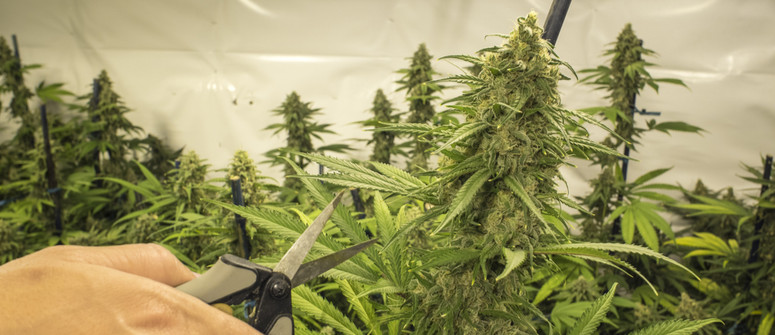
Pruning cannabis is a valuable part of the growing process, for both beginners and experts. This article delves deeper into what this practice is all about, its importance, and how to do it the right way.
Contents:
- What Is Cannabis Pruning?
- Different Cannabis Pruning Techniques
- Why Should You Prune Marijuana Plants?
- Are There Any Risks to Marijuana Pruning?
- When Should You Prune Cannabis?
- How To Prune Cannabis for Beginners
- What Are the Best Pruning Shears for Cannabis?
- What To Do With Cannabis Trimmings?
- Cannabis Pruning for Beginners: Helping You Improve Yields
Cultivating your own cannabis crop is definitely not a walk in the park. There are many necessary steps you can’t skip or ignore, otherwise you risk growing an inferior batch of buds.
Although not strictly necessary, one of the most beneficial steps one can take in the cannabis growing process is pruning. The basic idea of pruning marijuana plants is to cut off sections of the plant during the vegetative or early flowering stage.
Cannabis growers prune for various reasons: to increase yield, improve airflow, and enable healthier growth. It also makes the trimming process a lot easier, but that’s another topic of discussion.
For this article, we’ll delve deeper into the practice of pruning, the different techniques, and the right time to do it. If you’re pruning for the first time, we also have a section dedicated to you.
But whether you’re a first-time grower or an expert cultivator, there’s something valuable to learn from this guide.
What Is Cannabis Pruning?
In principle, pruning involves removing unproductive or damaged sections of the cannabis plant to encourage healthier overall growth. It’s also done to allow more sunlight and air to pass through the lower parts of the plant.
As the remaining leaves receive more nutrients, the plant subsequently grows to be sturdier, with denser buds.
What’s the Difference Between Pruning and Trimming?
It’s easy to confuse trimming with pruning, and vice versa, and understandably so. Both of these practices involve cutting off parts of the plant, but for different purposes.
Pruning is more about snipping off larger sections of the plant during growth. It’s also about doing damage control if, let’s say, you’re eradicating dead or infected leaves or branches.
Trimming, on the other hand, is more about enhancing the plant’s features. You’re cutting off fan leaves and sugar leaves from the main cola and surrounding buds to improve aesthetics and aroma. The finer details of this process are carried out post-harvest. Ultimately, trimming allows for a smoother smoking experience.
Different Cannabis Pruning Techniques
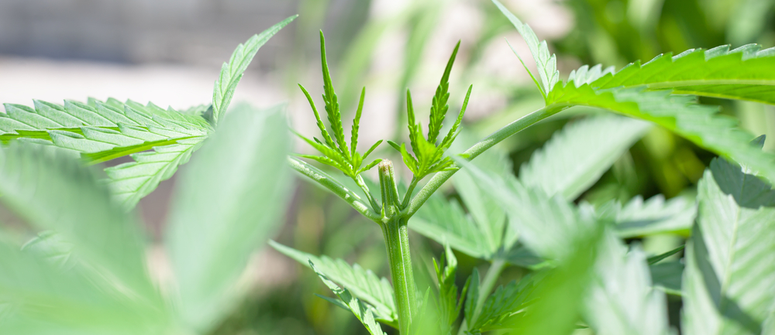
There are three main methods utilised by experienced growers to prune cannabis plants. If you’re a beginner, this section isn’t for you yet. Nonetheless, these are techniques worth knowing for when you become more experienced.
Topping
One of the principles of pruning is training and manipulating the cannabis plant to grow in a certain way. Topping is one of the techniques that capitalises on this idea.
Cannabis plants naturally grow into a Christmas-tree like shape. At the top of the plant, you’ll have one dominant stem where the main cola eventually develops. Below it are multiple side branches.
As the name suggests, the concept of topping is to prune the tip of the main stem. As a result, when the stem grows back, it will do so in a V-shape, eventually resulting in two main colas. This process also allows the lower part of the plant to receive more light and air, which promotes more robust growth.
Expert cultivators recommend topping within the first four weeks of the vegetative phase. At this point, the plant should have developed 3–5 nodes. The roots and stem should also be strong enough to recover from the stress of the topping process.
Fimming
Just like topping, increasing yields is the goal behind fimming. And if you do it right, you’ll potentially get not just two, but at least four brand new main colas. Another difference here is that if topping leads to horizontal, dense growth, fimming allows for taller plants.
FIM literally means “f--- I missed”, which denotes a slightly sloppier technique and a missed topping attempt. This method involves cutting off about 75% of the plant’s tip.
But just like topping, you know your cannabis plant is primed for fimming once you see it develop about 3–5 nodes. It’s key to do this process during the mid-vegetative phase, as doing it too early, or late, could shock the plant.
Lollipopping
Don’t let the funny-sounding name throw you off. The method itself is necessary to ensure you’re getting top-shelf buds come harvest time.
While topping and fimming involve manipulating the tip of the plant, lollipopping is the exact opposite. Here, you’re getting rid of the lower branches of the cannabis plant that don’t get much exposure to light. These areas produce smaller buds and slow down the growth and production of other, well-nourished regions in the plant.
It’s called lollipopping because, by taking out the lower branches and bud sites, you get a fuller upper region that resembles the shape of a lollipop. And if you do it correctly, your plant will develop thicker buds in those regions that absorb the most sunlight.
Unlike the two aforementioned forms of pruning, lollipopping happens a bit later. Experts recommend doing this around the second week of the flowering stage.
Defoliation
Here’s another pruning process that allows the plant to absorb more light. Defoliation basically involves cutting off excess fan leaves to open up the lower part of the plant to more light.
Now, there is some debate on whether or not defoliation is beneficial for a cannabis plant’s growth. Some argue that cutting off fan leaves may adversely affect the overall yield. Others claim there’s no effect at all on yield. But then there are those who assert its yield-boosting benefits.
Regardless of which side you're on, it’s important to note that the correct process should be followed to see your desired results. Defoliation is ideally done in the later stages of vegetation, after you’ve done some topping.
Apart from added light, defoliation helps to enhance airflow throughout the plant. This lessens the likelihood of mould development, which can easily destroy your entire crop in one fell swoop.
Root Pruning
Sometimes we have no other choice but to grow in small containers. But if you try to unravel what’s happening underneath the soil, you’ll see an entangled mess of overgrown roots. The roots will begin to grow circularly and end up choking off the root mass.
This, in turn, causes plants to be root bound. And once this happens, the overall root function is obstructed, leading to stunted growth and decreased yields. That’s never good.
Your best recourse here is to do some root pruning. You can either do this manually, by directly cutting into the roots, or by air pruning. The latter is a more natural process where you expose the roots to natural air. As a result, the excess roots fall off and growth is no longer obstructed.
Root pruning is usually done to mother plants. If you’re taking cuttings first, be sure to allow a three or four-week recovery period before root pruning. This avoids stressing the mother plant in the process.
The best way to promote natural air pruning is to invest in a fabric pot or “smart pot” of some sort from the onset. In this case, you shouldn’t run into root-bound plants to begin with. But you can also transplant vegging plants into a suitable fabric pot.
Why Should You Prune Marijuana Plants?
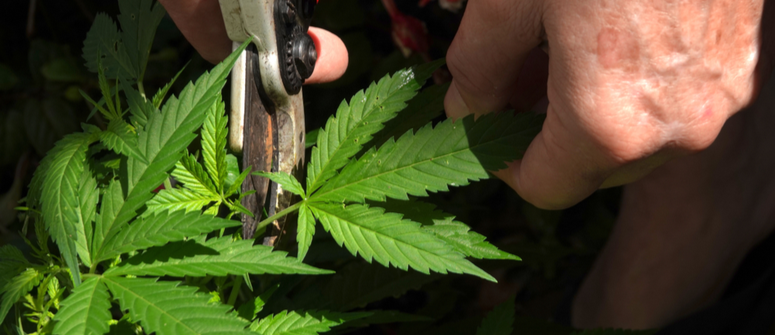
We’ve gone through the important reasons you should prune your marijuana plants. But some of you are probably wondering what its other benefits are.
Apart from better yields and well-nourished plants, pruning also helps to maintain overall health.
Leaves that begin to discolour to a yellow or brown hue are either diseased or on the verge of death. They can either harm other healthy leaves or attract pests and other invasive microorganisms. If you see this, the best option is to get rid of them.
Can You Prune Autoflowers?
Short answer: Yes, you definitely can. But is it necessary to do so? Not so much.
That’s because autoflowering plants have a much quicker growth cycle. Pruning may cause some lost growth time because plants need to recover from all the stress.
You can still prune autoflowering plants that have grown way too large. Likewise, topping or fimming can still encourage lateral growth.
Are There Any Risks to Marijuana Pruning?
There's a reason pruning is a much-debated process in cannabis growing. While many cultivators swear by it as an important step, there are some risks involved.
The biggest risk is over-defoliation—taking out too many fan leaves. As a result, photosynthesis gets compromised, which may also lead to an unhealthy plant.
Mistakes can definitely occur, especially if you’re a beginner. But by following this guide, you can minimise errors and ensure better growth for your beloved plants.
When Should You Prune Cannabis?
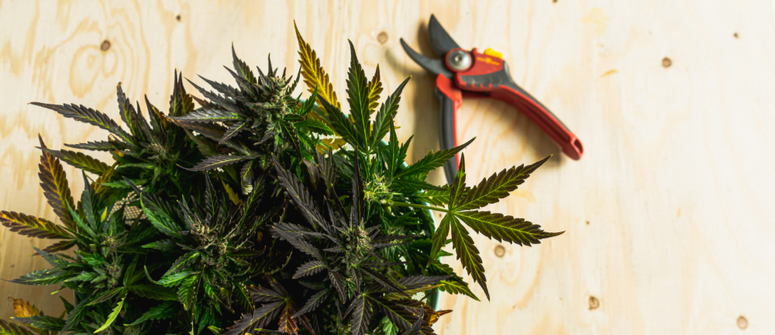
There is a right time to prune your plants, depending on the method. Doing it too early may cause damage. On the other hand, pruning a little too late may lessen the chance of getting the increased yields you're after. At worst, it may even prevent flowering.
For most techniques, aside from lollipopping, the ideal pruning time is during the vegetative stage when plants have reached a height of about 12 inches (~30cm). Around this time, the plant should already be well-established with a good number of leaves present.
How To Prune Cannabis for Beginners
If you’re pruning for the first time, the aforementioned methods may be a bit too complicated. So as a beginner reading this, allow us to simplify things for you.
The easiest route to go with is to simply check for any dead leaves or branches. Once you spot them, immediately take them out. This pruning method may seem super simple, but that's the point. By only removing dead or dying growth, you eliminate the chance of stressing out your plant and ruining its health.
If you want to take things a little further, you can remove just a few branches to maximise the final outcome of your crop.
The first thing to set your focus on is the larger branches. Cutting them off just gives you more clearance to operate at a more detailed level. You’ll want to begin at the bottom where sunlight isn’t penetrating that much.
Next, move slightly up to the middle region. Check if any branches are deprived of light exposure and cut them off as well. There is no point in keeping these branches since they will never fully develop due to the lack of light.
Prune Sparingly but Effectively
We mentioned checking for dead leaves and branches. As someone pruning for the first few times, this the easiest and most careful pruning method to go with.
For one, you’re still learning about pruning and its importance to the growth of your plants. But at the same time, you’re lowering the risks of committing crucial mistakes that may cause irreversible harm.
If you’re a beginner reading this article, focus on this method to start. Then, as you gain experience, you can gradually try out the other pruning practices we mentioned.
What Are the Best Pruning Shears for Cannabis?
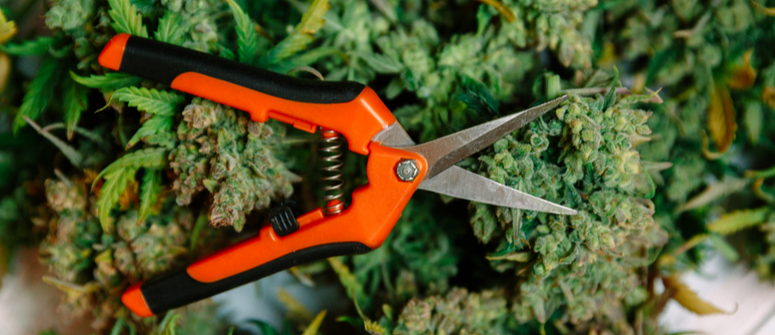
First, you must know the distinction between pruning shears and trimming scissors. It’s very simple: the former are for stalks and branches and come with stronger, thicker blades. The latter are more for leaves, and are a bit more compact in size.
In the case of ideal pair pruning shears, here are some traits you’ll want to look for:
• Durability: A good pair of pruning shears should be able to withstand multiple pruning sessions.
• Comfort: Your hands will be working for a long time, so you’ll want a spring-loaded feature that snaps back immediately.
• Stainless steel blades: You don’t want the blades of your pruners to develop rust after a few cleanings.
Here’s an example of a good pair of pruning shears. It has all the aforementioned features, but one that stands out is it suits both lefties and righties. It’s also very affordable, even if you get the two-pack option.
What To Do With Cannabis Trimmings?
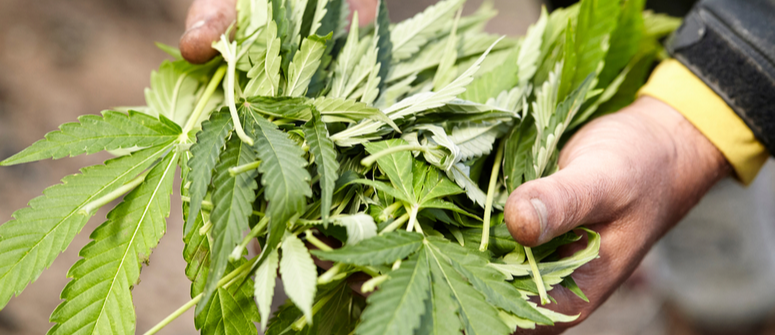
Unless they’re dead or diseased, you can still make good use of your cannabis trimmings. The fan leaves, especially, can be a primary ingredient in cannabutter or cannaoil.
But if you don’t want to take that extra step, you can also turn them into hash or create an extract. Juicing the fan leaves is another option. If you need recipes, a quick Google search should help you out. You can even be as straightforward as using the fan leaves as a pizza topping.
And in case you don’t want to go the edible route, you can also make a topical cream or balm out of them. The process itself is a bit extensive, but very much doable.
Cannabis Pruning for Beginners: Helping You Improve Yields
As you can see, pruning is very much doable, even for beginners. There are simpler ways to do it, but if you want to level up, lollipopping would be a good place to start.
If done correctly and carefully, you’ll be able to achieve desirable results in the form of robust, high-yielding plants. So do yourself a favour and be sure not to skip this very important step. You’ll thank yourself later.
.jpg)
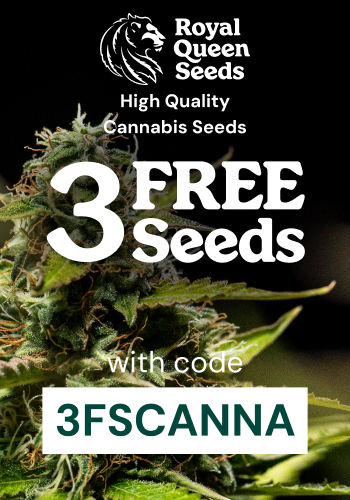

.jpg)
